The later eighteenth century represents a particular moment when the competing claims of anatomy and criminal justice fought for supremacy over the criminal corpse. In both 1786 and 1796, schemes were put before Parliament that sought to extend the 1752 Murder Act by handing surgeons the bodies of offenders executed for a whole range of offences, including burglary, robbery, rape and arson. Both of these proposals were put forward with the needs of anatomy in mind, yet both failed to pass into law due to concerns about the negative effects they would have in terms of criminal justice.
The first proposal, of 1786, was in fact put forward in Parliament by the famous reformer William Wilberforce. When introducing the scheme in Parliament, Wilberforce drew attention to “the extreme difficulty that surgeons experienced in procuring bodies for dissections, and the shocking custom of digging them up after burial.” The bodies snatched from graves were often in such a poor state, he argued, “that their dissection has proved fatal to the anatomists themselves, and put an end to their lives, instead of contributing to the lives of others.”
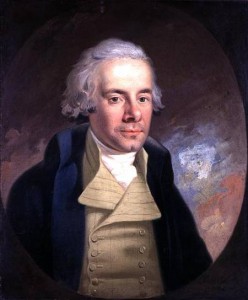
WHM146809 Portrait of William Wilberforce (1759-1833), 1794 (oil on canvas) by Hickel, Anton (1745-98)
oil on canvas
© Wilberforce House, Hull City Museums and Art Galleries, UK
German, out of copyright
But whilst Wilberforce was the man who presented this to Parliament, the scheme had in fact originated with his close friend and medical advisor, a surgeon of Leeds named William Hey. Hey was also disgusted at the practice of body snatching by surgeons, but he clearly had personal aims in mind too for increasing the number of criminal corpses available to anatomists for dissection. He was convinced about the importance of dissection for developing surgical skills, and he was also in the process of taking on medical students which required corpses for practice.
But perhaps even more importantly, Hey also conducted anatomical demonstrations attended by members of the public, no-doubt a useful way for Hey to promote his skills in an era of private healthcare. A Gunther von Hagens of his day, William Hey’s demonstrations on the bodies of executed offenders played to large audiences, although he was careful not to attract the wrong crowd: women were excluded and the half a guinea entrance fee prevented the intrusion of “improper persons”. More criminal corpses meant more of these lucrative opportunities for Hey.
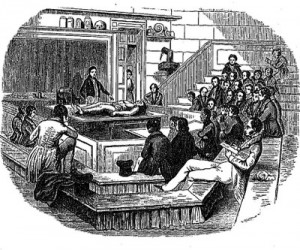
This attempt to extend the practice of dissecting executed criminals for the benefits of anatomists however fell on deaf ears in Parliament. The law-makers of eighteenth-century England were instead convinced that the dissection of criminals should first and foremost be used for the ends of punishment. Lord Loughborough, Lord Chief Justice of the Common Pleas, complained that by making the punishment for burglary and murder the same, “breaking open a house would therefore be generally attended with murder, as robberies in France were, the criminals there knowing that the commission of the one crime was to receive no greater punishment than the other.”
In the later eighteenth century, therefore, competing claims were made over the criminal corpse by the needs of anatomy on the one hand and the needs of criminal justice on the other. In this era of judges in the House of Lords and a well-developed legal system, but a far less well-developed medical system, the needs of criminal justice won the day. Medical science simply couldn’t compete against the power of judicial interests in Parliament. The gavel was mightier than the scalpel.
This was a hard knock for the anatomists to take, and one that they would experience many times again in the nineteenth century as they violated the sanctity of the grave in the cause of medical science. Clearly unable to claim supremacy over the criminal corpse, with the 1832 Anatomy Act anatomists therefore turned to the dead poor — those friendless, destitute individuals who perished in prisons, workhouses and asylums — as a source of bodies for dissection. Unlike criminals, who had the legal system watching over their corpses, the dead poor — to the shame of our nineteenth-century ancestors — had nobody in Parliament on their side.
Richard Ward is currently a Research Associate at the University of Sheffield, working on a major, interdisciplinary project, The Digital Panopticon: The Global Impact of London Punishments, 1780–1925 (http://www.digitalpanopticon.org/), funded as part of the AHRC’s ‘Digital Transformations’ programme. Richard’s first monograph, Print Culture, Crime and Justice in Eighteenth-Century London (Bloomsbury, 2014), provides the first detailed study of crime reporting across a range of eighteenth-century publications (including newspapers, the Old Bailey Proceedings, Ordinary’s Accounts and graphic prints) to explore the influence of print upon contemporary perceptions of crime and upon the making of the law and its administration in the metropolis.

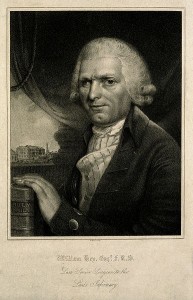
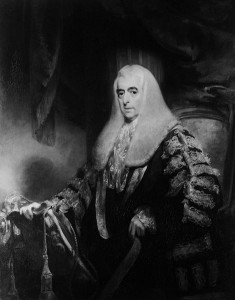
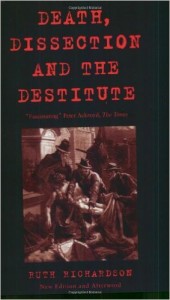

 Subscribe to Emma Battell Lowman's posts
Subscribe to Emma Battell Lowman's posts
Recent Comments